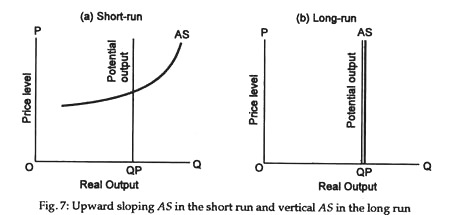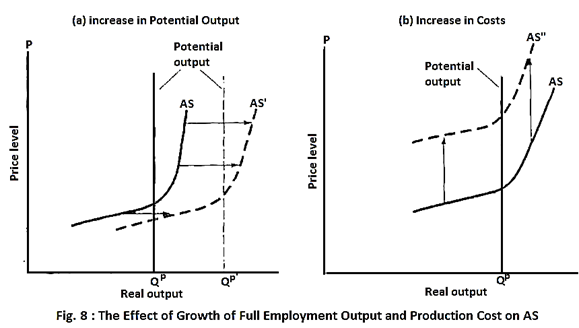Get the answer of: What is Aggregate Supply (AS)?
Aggregate supply (AS) describes the behaviour and responsiveness of all producers (business firms) to price changes.
The two main forces lying behind AS are:
(i) The level of potential output (which depends on the state of the economy, i.e., whether it is at full employment or having unemployed resources), and
ADVERTISEMENTS:
(ii) Cost conditions which largely depends on input prices.
The AS curve plays a crucial role in both static and dynamic analysis. In the short run the AS curve along with the AD curve determines the level of output (GNP), the level of employment -(unemployment) and capacity utilisation as also the general price level (i.e., the impetus to inflation). In the long run, AS acts as the major determinant of economic growth.
In the short run a fall in AD, according to Keynes, will lead to a fall in output and employment. However, in the long run, if AD increases AS may also increase (through an expansion of society’s production capacity) to enable any economy enjoy a higher living standard (by achieving a faster growth). Thus, in the long run AD is less important than AS in explaining growth of nations.
Alternative Approaches to AS:
Aggregate supply refers to the total national output that business firms are desirous of producing and offering for sale in an accounting year for each level of prices, other things held constant. Like the supply curve of an individual firm, it is possible to construct AS curve from the AS schedule which shows the level of real output that will be produced at each possible price level, other things held constant.
ADVERTISEMENTS:
AS curves can be divided into two categories — short-run AS curves and long-run AS curves. A short-run AS curve (which is relevant for a few months or years) slopes upward from left to right, indicating that increases in prices are associated with output increases.
In contrast, the long-run AS curve (which is relevant for several years or even a decade or more) is usually shown as a vertical straight line, implying that increases in the price level do not lead to any increase in total output supplied. See Fig. 7.
Determinants of AS:
There are two determinates of AS, viz., potential output and factor prices:
ADVERTISEMENTS:
1. Potential output:
The proximate determinant of AS is an economy’s potential (full employment) output, i.e., the maximum capacity output. Here potential output or GNP represents the maximum amount of output society is capable of producing by using all its resources and existing technology while, at the same time, maintaining stable prices.
If the economy seeks to purchase more than its potential output by utilising its resources more intensively, prices will rise. If, on the other hand, the economy is able to produce less than its potential output, there will exist idle capacity and high unemployment.
According to Paul Samuelson and W.D. Nordhaus, “Between the extremes of too-high utilisation of capacity and too-high unemployment of inputs is a threshold level of output that we designate potential output”.
Society’s actual output may well fall short of its potential output for various reasons — such as price hike, fall in aggregate demand, natural calamities and other exogenous shocks, or sudden changes in government policy (such as an act of nationalisation) or even wars and revolutions.
2. Factor prices:
Apart from potential output AS aggregate depends on factor prices. If factor prices and production cost rises, producers will be able to offer a larger quantity for sale only at a higher price. Thus, for example, if factor prices (such as wages and other input costs) rise so rapidly, that costs of production get doubled, then the same quantity would be offered for sale by business firms at double the price.
Fig. 8 shows the AS curve. Fig. 8(a) shows that if there is an increase in potential output, with no change in production costs, the AS curve will shift to the right from AS to AS’, implying that a larger quantity will be offered for sale at the same price. If, on the other hand, production cost rises, with no change in potential output, the AS curve will shift upward, implying that the same quantity will now be offered for sale at a higher price.
Short-Run and Long-Run AS Curves:
The Keynesians hold the view that the AS curve is relatively flat as shown by Fig.8 (a). This curve slopes upward from left to right because most components of total costs are inflexible in the short run. Thus; it is quite obvious that with the fixed wage-interest and rents, business firms will offer a larger quantity for sale as prices rise.
ADVERTISEMENTS:
In other words, in the short run, business firms respond quickly to an increase in AS by raising both output and price. This means that increases in AD will have significant and permanent effect in output. In contrast, the followers of the classicists hold that the AS curve is steeper, in the limiting case, even vertical.
Such a curve is shown in Fig. 8(b), indicating that actual output is the same as potential output. Therefore, changes in AD, in such a situation, will have little, if any, long-term effect on aggregate output. In such a situation, the level of aggregate output is quite independent of the general price level.
However, in the long run costs respond to the higher general price level, in which case, most or all of the response to increased demand takes the form of higher prices and little or none the form of sufficient increased output. Since, given time, all costs adjust, the long-run AS curve is a vertical straight line.

